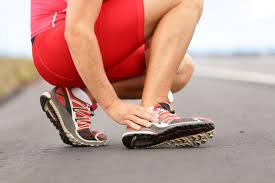Sports Injury? Follow the P.R.I.C.E protocol for enhanced recovery
I often see people several weeks/months after they have had a sporting injury and hear widely varying accounts from patients on how they managed their injury in the important initial stages. Correct management and care of a sports injury can help to promote an faster healing and recovery process, helping you to get back to doing the sport/activity you love with minimal delay.
Here’s some helpful tips on how to safely manage most acute sports injuries using the P.R.I.C.E. principle. If you have any doubts about your injury, heard any noises during injury, or have great difficulty weightbearing, walking or moving the affected joint/area, please seek professional medical assistance. Here is a link where you can locate your closest Accident & Emergency department. 
- PROTECTION: The purpose of protection is to avoid further injury to the area by protecting the injured structures. The type of protection used varies depending on the injured area but may include an elastic bandage, sling, protective tape, or over-the-counter brace.
- REST: The purpose of resting is to allow the body’s own healing processes to naturally occur without being impeded by movement of the injured area. Any increase in movement of an injured tissue results in increased circulation to the area which in turn may result in further damage to the injured tissue and/or increased swelling.
- ICE: Apply an ice pack as soon as possible to the injured area, this is done to help limit and reduce inflammation and to reduce any internal bleeding/bruising at the injury site. To ice an injury, wrap ice (a bag of frozen peas works very well from personal experience) in a thin towel and place it on the affected area for 10 minutes at a time. Allow the skin temperature to return to normal before icing a second or third time. You can ice an acute injury several times a day for up to three days. Do not apply heat to an acute injury as heat will increase circulation and increase swelling.
- COMPRESSION: When the ice pack is removed, a compression wrap should be applied to the injured area. The compression wrap serves as a mechanical barrier so that swelling is minimized in the injured area. The most commonly used is an elastic bandage, the size of the body part injured will determine the size of the bandage.
- ELEVATION: Elevation is important immediately post-injury to reduce the amount of blood flow to the injured area. For the lower extremities, elevate your leg by lying down and elevating the injured limb on pillows. The key is that you should have the injured area above your heart level.
 Posted by bodyworks73
Posted by bodyworks73- Posted in Blog
 Feb, 21, 2015
Feb, 21, 2015 No Comments.
No Comments.
Testimonials
Vicky Carling-Roberts
Having regular therapy has made a huge positive difference in reducing acute exacerbations of a recurring injury I had
- Vicky Carling-Roberts
Having regular therapy has made a huge positive difference in reducing acute exacerbations of a recurring injury I had
- Vicky Carling-Roberts
Dr. Jacques Behmoaras
I swim three times a week and get sometimes back or neck pain. I found the remedial massage extremely efficient as it allowed me to continue swimming in the same frequency, significantly reducing my back pain
- Dr. Jacques Behmoaras
I swim three times a week and get sometimes back or neck pain. I found the remedial massage extremely efficient as it allowed me to continue swimming in the same frequency, significantly reducing my back pain
- Dr. Jacques Behmoaras
Lina Tayara
Maria is an accomplished therapist, not only conscientious but also pleasant. She treated my chronic shoulder pain in a way that not only eased it but dealt with its cause.
- Lina Tayara
Maria is an accomplished therapist, not only conscientious but also pleasant. She treated my chronic shoulder pain in a way that not only eased it but dealt with its cause.
- Lina Tayara
Kerttu Inkeronian
Maria is fantastic - as a climber I often get muscle pains, especially in the upper body, and Maria has never failed to cure these. She is very skilled and the massage is different every time, based on treatment needs. Highly recommended!
- Kerttu Inkeronian
Maria is fantastic - as a climber I often get muscle pains, especially in the upper body, and Maria has never failed to cure these. She is very skilled and the massage is different every time, based on treatment needs. Highly recommended!
- Kerttu Inkeronian
Catherine Mulligan
I was having difficulties running due to pain in my neck and back. Maria did a fantastic job of analysing the underlying issues causing the pain and tailoring the massages to solve them. Cannot recommend highly enough.
- Catherine Mulligan
I was having difficulties running due to pain in my neck and back. Maria did a fantastic job of analysing the underlying issues causing the pain and tailoring the massages to solve them. Cannot recommend highly enough.
- Catherine Mulligan

 Call Us (111) 234 - 5678
Call Us (111) 234 - 5678
